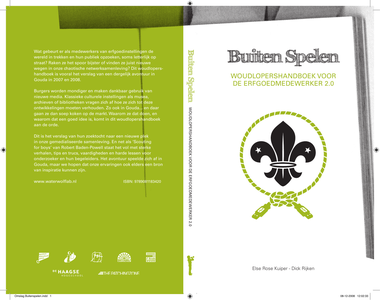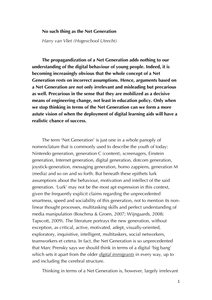This video presents BiebBeep, an interactive touchscreen system that has been developed with the aim to support information and social services for the New Library in Almere, The Netherlands. The constantly updated information displayed on the interactive screen concerns not only the library itself, but also features happenings in the local area. The system's distinctive feature is that people can add information to the screen themselves, such as tweets, photos, local and cultural news announcements, so that the library and its visitors can inform and connect with each other. Over the course of almost one year, several studies were conducted, including focus group, interview- and observation-based studies that have motivated the functionality, and particularly the user-generated and localized content the system supports. Consequently, the services and functionality the system offers are aimed towards supporting Library 2.0, the next generation library.
MULTIFILE

In dit artikel wordt ingegaan op de snel veranderende digitale wereld. Want het stof rondom de term 'web 2.0' mag zo langzamerhand dan wel opgetrokken zijn, vragen blijven er genoeg. Welke impact hebben al die elkaar steeds sneller opvolgende ontwikkelingen nu eigenlijk op bibliotheken? In hoeverre dringt web 2.0 al door in de organisatie, in de werkprocessen, de klantbenadering en in de digitale bibliotheek? Vergt het wellicht ook een andere attitude van de bibliotheekmanager? En welke gevolgen heeft web 2.0 voor het functieprofiel van de informatiespecialist? Vragen als deze en nog meer, worden in dit artikel verder uitgediept.
DOCUMENT

This paper presents the design and long-term study of BiebBeep, a large interactive touchscreen that has been developed with the aim to augment the information and social function of a library. BiebBeep displays user-generated and context-relevant content, such as information about local events and book trailers. The system’s distinctive feature is that people can add information to the screen themselves, such as tweets and Flickr photos, so that the library and its visitors can inform and connect with each other. For more than a year, the BiebBeep system has been iterated and studied in the library. The research approach presented is an exemplar of the study of a public screen in situ for long-term to best meet the demands for its actual use in present and future.
DOCUMENT

This speech discusses how the professorship intends to support practitioners in the nursing domain and contribute to shaping nursing leadership and each person's professional individuality. The title of the speech, “Notes on Nursing 2.0,” is particularly intended to emphasize the need for these changes in the nursing domain. Not by assuming that nothing has changed in care and nursing since Nightingale's time. There has. Being educated in the professional domain is not only a given but a requirement. The knowledge domain of care and nursing has developed far and wide in nursing diagnostics and standards. Nursing science research, which Nightingale once started as the first female statistician in the British Kingdom, has firmly established itself in education and practice. Wanting to be of significance to others out of compassion is still the professional motivation, but there is no longer a subservient servitude (Cingel van der, 2012). At the same time, wholehearted leadership is not yet taken for granted in daily practice and optimal professional practice falters due to an equality principle of differently educated caregivers and nurses that has been held for too long. That is the need for change to which this 2.0 version “Notes on Nursing” and the lectorate want to contribute in the coming years. Chapter 1, through the metaphors in the story “The Cat Who Looked at the King,” describes the vision of emancipatory action research and the change principles that the lectorate will deploy. Chapter 2 contains the reason, mission and lines of research that are interrelated within the lectorate. Chapters 3 and 4 address the themes of identity and leadership, discussing their interrelationship with professional practice and developing a research culture. In addition, specific aspects that influence practice and work culture today are addressed, and how the lectorate contributes specifically to the development of nursing leadership and the formation of professional identity in the relevant domain is described. Chapter 5 contains a summary of the principles on which the research program is based, as well as information on current and future projects. Chapter 6 provides background information on the lector and the members of the knowledge circle.
DOCUMENT

In april '07 vond in de VS het congres 'Computers in Libraries' plaats. Gerard Bierens en Liesbeth Mantel signaleren de opvallendste trends. 'De bibliotheekcatalogus gaat onherroepelijk onder het mes.'
DOCUMENT

On the internet we enjoy a continuously growing generation of web applications enabling anyone to create and publish online content in a simple way, to link content and to share it with others. The internet has become a social software platform sailing under the Web 2.0 flag, creating revolutionary changes along the way: the individual, the end-user, comes first and can benefit optimally from an environment which has the following keywords: radically user-oriented, de-centralized, collective and massive. An environment in which each participant not only listens, but can also make his own voice heard: the Social Web.
DOCUMENT

Wat gebeurt er als medewerkers van erfgoedinstellingen de wereld in trekken en hun publiek opzoeken, soms letterlijk op straat? Raken ze het spoor bijster of vinden ze juist nieuwe wegen in onze chaotische netwerksamenleving? Dit woudlopershandboek is vooral het verslag van een dergelijk avontuur in Gouda in 2007 en 2008. Burgers worden mondiger en maken dankbaar gebruik van nieuwe media. Klassieke culturele instellingen als musea, archieven of bibliotheken vragen zich af hoe ze zich tot deze ontwikkelingen moeten verhouden. Zo ook in Gouda... en daar gaan ze dan soep koken op de markt. Waarom ze dat doen, en waarom dat een goed idee is, komt in dit woudlopershandboek aan de orde. Dit is het verslag van hun zoektocht naar een nieuwe plek in onze gemedialiseerde samenleving. En net als 'Scouting for boys' van Robert Baden-Powell staat het vol met sterke verhalen, tips en trucs, vaardigheden en harde lessen voor onderzoeker en hun begeleiders. Het avontuur speelde zich af in Gouda, maar we hopen dat onze ervaringen ook elders een bron van inspiratie kunnen zijn.
DOCUMENT

In dit boekje over crowdsourcing worden een aantal relevante aspecten van crowdsourcing behandeld. Allereerst beschrijven we een aantal historische voorbeelden om duidelijk te maken dat crowdsourcing niet ontstaan is als gevolg van de opkomst van internet maar als fenomeen al bestond voor het internettijdperk. Door internet is het echter zonder meer eenvoudiger geworden crowdsourcing te organiseren en een veel grotere groepen deelnemers te betrekken. In de sectie 'Wisdom of the Crowds' gaan we in op de onderliggende principes van crowdsourcing. Crowdsourcing wordt vaak in één adem genoemd met de 'Wisdom of the Crowds', als onderliggend mechanisme hoe en waarom crowdsourcing werkt. We zullen echter concluderen dat de 'Wisdom of the Crowds' slechts één van de drie onderliggende principes van crowdsourcing is. Vervolgens gaan we in op de verschillende verschijningsvormen van crowdsourcing. Na een reflectie op bestaande voorstellen om tot een categorisering te komen van deze verschijningsvormen, presenteren we zeven categorieën op basis van het te onderscheiden doel. Bij de keuze om crowdsourcing in te zetten zal naar de kosten, risico's en baten ervan gekeken moeten worden. In de sectie 'Kosten en baten van crowdsourcing' bekijken we dit aspect voornamelijk vanuit het perspectief van de initiërende organisatie. Maar de kosten en baten voor de deelnemers zullen ook kort beschreven worden om te begrijpen wat hen drijft om aan een crowdsourcingproject mee te doen. In de laatste sectie beantwoorden we de vraag hoe crowdsourcing zo effectief en efficiënt mogelijk is in te zetten door naar een aantal implementatiemodellen te kijken en algemene adviezen te inventariseren. We sluiten af met een reflectie op de beschreven bevindingen.
DOCUMENT

The propagandization of a Net Generation adds nothing to our understanding of the digital behaviour of young people. Indeed, it is becoming increasingly obvious that the whole concept of a Net Generation rests on incorrect assumptions. Hence, arguments based on a Net Generation are not only irrelevant and misleading but precarious as well. Precarious in the sense that they are mobilized as a decisive means of engineering change, not least in education policy. Only when we stop thinking in terms of the Net Generation can we form a more astute vision of when the deployment of digital learning aids will have a realistic chance of success.
DOCUMENT

This publication gives an account of the Public Annotation of Cultural Heritage research project (PACE) conducted at the Crossmedialab. The project was carried out between 1 January 2008 and 31 December 2009, and was funded by the Ministry of Education, Culture, and Science. Three members of the Dutch Association of Science Centres (Vereniging Science Centra) actively participated in the execution of the project: the Utrecht University Museum, the National Museum of Natural History (Naturalis), and Museon. In addition, two more knowledge institutes participated: Novay and the Utrecht University of Applied Sciences. BMC Consultancy and Manage¬ment also took part in the project. This broad consortium has enabled us to base the project on both knowledge and experience from a practical and scientific perspective. The purpose of the PACE project was to examine the ways in which social tagging could be deployed as a tool to enrich collections, improve their acces¬sibility and to increase visitor group involvement. The museums’ guiding question for the project was: ‘When is it useful to deploy social tagging as a tool for the benefit of museums and what kind of effect can be expected from such deployment?’ For the Crossmedialab the PACE project presented a unique opportunity to conduct concrete research into the highly interesting phenomenon of social tagging with parties and experts in the field.
DOCUMENT
